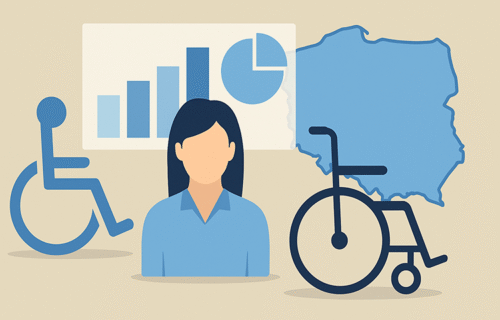As of the end of 2024, nearly 3.9 million people in Poland had a legally recognised disability, representing 10.5% of the country’s total population, according to new data from Statistics Poland. The figures are based on valid certificates of disability or incapacity to work issued by authorised medical committees and institutions.
Most persons with recognised disabilities—about 3 million—held certificates issued by medical examination committees, while 1.68 million held certificates from the Social Insurance Institution (ZUS). A smaller share had documents issued before 1998 by the Agricultural Social Insurance Institution (KRUS) or the Ministries of Defence and Internal Affairs.
Women accounted for 53.3% of all people with certified disabilities, and the largest age group was between 70 and 74 years, numbering more than 550,000.
In terms of severity, 41.1% of certificates confirmed a moderate level of disability, 29.9% a severe level, and 24% a mild level. About 5.8% of certificates were issued for children under 16 years old without a specified category.
Regional data show that the highest number of people with disabilities lived in Śląskie Voivodeship (448,000), while the lowest number was recorded in Opolskie (85,600). The highest rate of disability per 1,000 residents was in Lubuskie Voivodeship (160.7), with the lowest in Mazowieckie (74.0).
Motor impairment remained the most common cause of disability, affecting about 1.38 million individuals, followed by cardiovascular and musculoskeletal conditions. The smallest group—around 68,000 people—were certified due to epilepsy.
More than 793,000 people with valid disability certificates also held parking cards, most commonly in Lubuskie, where the rate reached 33.4 per 1,000 residents.
The report notes that 24,800 outpatient clinics and medical practices, representing 91% of all facilities, were adapted to the needs of people with disabilities. Among cultural institutions, 55% had at least one adaptation, with cinemas showing the highest level of accessibility.
In transport, 97.6% of buses and 57.5% of trams were equipped for passengers with disabilities.
Education data reveal that during the 2024/25 school year, 279,900 children and young people with special educational needs attended schools—5.3% of all students. At the university level, 23,500 students with disabilities were enrolled, accounting for 1.9% of the total student population.
Statistics Poland said the figures were compiled from multiple national databases, including medical examination committees, ZUS, KRUS, and the Ministries of Defence, Interior, and Education. The data provide an updated view of disability in Poland, reflecting both demographic trends and ongoing efforts to improve accessibility and inclusion across sectors.
Source: GUS
